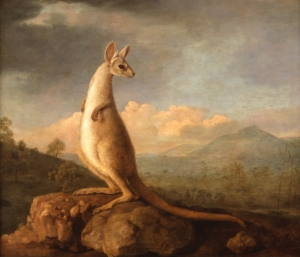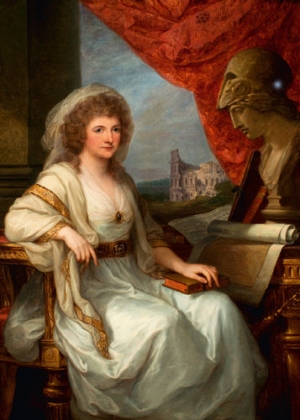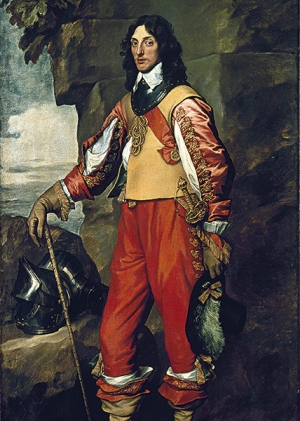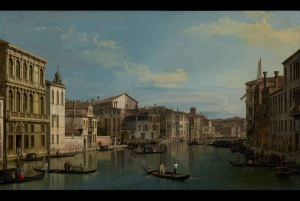|
Displaying items by tag: 18th Century
Lots of people have a stray fuzz ball or two kicking around under the sofa, or perhaps a missing sock to match the lonely one at the bottom of the laundry hamper.
Christina Jones Janssen had something more valuable under the couch in her Bay Area home — a lost and extremely rare masterpiece of 18th century painting, neatly rolled up and remarkably well-preserved.
She suspected it might be important, and her sleuthing led to what art experts are calling one of the most important discoveries of Mexican Colonial art in recent memory.
Sections of 18th-century gilded walls and paintings of deities are sprawled across the floor of a warehouse on this city’s outskirts. After nine decades in limbo, this architectural salvage is being reorganized into period rooms that will rival Versailles’s for inventiveness and visual impact.
The pieces came from the interior of a townhouse built near the Louvre around 1707 for Philippe II, the duke of Orléans, a nephew of Louis XIV. In the 1920s, before demolishing the building so that its own quarters could expand, the Bank of France labeled and crated the pieces and pledged to recreate the rooms elsewhere. They will re-emerge in a year or so at a government building on Rue Vieille du Temple in the Marais, about a mile from their original home.
On Tuesday, January 21, France’s Minister of Culture and Communication, Aurélie Filippetti, announced that the country would return three artworks that were looted during World War II to their rightful owners. The works include a 17th century landscape by the Flemish painter Joos de Momper, an 18th century portrait, and an oil on wood Madonna.
The works are among over 2,000 objects that have been held in temporary custody by French museums since the end of World War II. Some critics have spoken out against France, claiming that the country has not been proactive enough in terms of restitution efforts.
Since the end of World War II, France has returned around 80 looted artworks.
Scott Schaefer, the J. Paul Getty Museum’s Senior Curator of Paintings, will retire on January 21, 2014. Schaefer joined the Getty in 1999 after stints at Sotheby’s, the Los Angeles County Museum of Art, the Museum of Fine Arts in Boston, the Fogg Museum at Harvard University, and the Philadelphia Museum of Art.
Schaefer, who helmed the Getty’s Paintings department for four years, helped the museum acquire a total of 70 paintings and pastels and five sculptures. Among the most important recent acquisitions are the Getty’s first paintings by Paul Gauguin, J.M.W. Turner’s Modern Rome, and a rare self-portrait by Rembrandt.
Timothy Potts, the Getty’s director, said, “Through his acquisitions, Scott has made an impact on every one of the Museum’s paintings galleries and, in particular, transformed our eighteenth-century French collection. We will miss his discerning eye, keen intelligence and above all his unswerving commitment to the Museum.”
Thieves have made off with valuables including priceless 18th century oil paintings from a colonial-era Roman Catholic church in Bolivia. Located in the small town of San Miguel de Tomave, the church has been looted three times in the last five years.
Churches in remote areas of Bolivia and Peru have recently fallen victim to repeated robberies. Thieves have gone so far as to create tunnels under church walls to make their way inside the structure undetected. Since 2009, Bolivian churches have allegedly been robbed 38 times of 447 objects including jewelry and silver.
Authorities claim that the thieves are stealing from the churches for collectors in Europe and the United States, where there’s a considerable market for Latin American art. Modest churches in sparsely populated areas are easy targets for the looters.

In February 2013, the British government placed a temporary export ban on two important oil paintings by George Stubbs (1724-1806), an English painter best know for his depictions of horses. The works, which went on display at London’s Royal Academy in 1773, gave the British public their first glimpse of a kangaroo and a dingo.
The export ban went into effect shortly after it was decided by the Reviewing Committee on the Export of Works of Art and Objects of Cultural Interest that the paintings were of outstanding significance for the study of 18th century exploration of Australia and the public dissemination of knowledge during the Enlightenment. The point of the export ban was to grant UK museums enough time to raise the £5.5 million necessary to keep the Stubbs paintings in the UK.
The National Maritime Museum in London has launched a £1.5 million bid to acquire Kongouro from New Holland (Kangaroo) and Portrait of a Large Dog (Dingo). The museum has already secured £3.2 million from the Heritage Lottery Fund and an additional £200,000 from the Art Fund. If the Maritime Museum’s appeal is successful, the paintings will initially go on display in the Queen’s House in Greenwich in 2014.
Stubbs created the Kongouro and Portrait of a Large Dog based on spoken accounts, as he had never actually seen the animals. It is believed that Sir Joseph Banks commissioned the paintings after assisting in Captain James Cook’s voyage to the Pacific. Following their completion, Stubbs won praise for bringing the likenesses of the foreign animals to the British public for the first time.

An 18th century portrait of the German Duchess Anna Amalia of Saxe-Weimar-Eisenach commissioned by the German writer Johann Wolfgang von Goethe has been returned to its rightful heirs after 70 years. The oil painting by Angelika Kauffmann went missing from the duchess’ descendants’ palace in Poland during World War II. The work did not resurface until 2011 when a Polish consignor brought the work to Sotheby’s.
The painting was returned to the city of Weimar during a ceremony at the Weimar palace. Michael Saxe-Weimar-Eisenach, the heir of the painting, has decided to loan the work to the city permanently. Upon its completion, the work, which is said to be worth hundred of thousands of euros, hung in the Roman House in Weimar, which was also commissioned by Goethe. The painting was later moved to the palace in Weimar and then to a family residence in Silesia, which is now part of Poland.
A Sotheby’s employee in London was the first to spot the painting on a German database for lost art. After reporting its reappearance to Weimar city officials, Sotheby’s held on to the painting until an agreement was reached. An exhibition of the work at the Roman House is being planned for next year.

Christie’s London will offer a Rococo coffee-pot by Paul de Lamerie (1688-1751), the most celebrated British silversmith of the 18th century, as part of its Exceptional Sale on July 4, 2013. The George II silver coffee-pot, which was commissioned in 1738 by a wealthy London-based merchant, is expected to become the most valuable piece of English silver ever to be sold at auction. The masterpiece was recently the highlight of a British silver exhibition at the Metropolitan Museum of Art in New York.
Lamerie, who began his career in 1703 as an apprentice to the London goldsmith, Pierre Platel (1659-1739), opened his own workshop in 1713 and was soon appointed goldsmith to George I. His work evolved from simple Queen Anne styles to classical French designs, but his ornate Rococo works of the 1730s are his most admired pieces. Lamerie’s illustrious clientele included Sir Robert Walpole, King John V of Portugal, and Queen Elizabeth II, who he made a wedding gift for.
The coffee-pot heading to auction in July is expected to garner approximately $4.5 million.

A selection of oil paintings from Russia’s Hermitage Museum will be on view at Houghton Hall in England from May 17, 2013 through September 29, 2013. Great Britain’s first prime minister, Sir Robert Walpole, assembled the collection during the first half of the 18th century and built Houghton Hall to house the works. Paintings from Russian and American collections will complement the works, which are returning to England for the first time in 230 years.
Walpole built Houghton Hall, which now belongs to Lord Cholmondeley, one of his direct descendants, between 1722 and 1735. In 1779,When Walpole’s grandson was in need of money, he sold the majority of his grandfather’s collection to Catherine the Great for nearly $61,500. Approximately 75 of the sold works are returning to Houghton Hall for the exhibition including paintings by Rembrandt (1606-1669), Anthony van Dyck (1599-1641), Nicolas Poussin (1594-1665), and Diego Velázquez (1599-1660).
While a handful of the paintings have been on view in England since their sale in the 18th century, none of them have returned to Houghton Hall. Designed by the foremost architects of Walpole’s time, James Gibbs and Colen Campbell, Houghton Hall’s lavish interior was decorated by the eminent architect and furniture designer William Kent. Walpole spared no expense and Houghton Hall remains as one of the finest examples of Palladian architecture in England.

The J. Paul Getty Museum in Los Angeles has acquired two major works of European art -- a self-portrait of Rembrandt (1606-1669) and a view of Venice’s Grand Canal by the Italian painter Canaletto (1697-1768). The portrait, titled Rembrandt Laughing (circa 1628), will round out the Getty’s collection of early works by the artist, which is the finest if its kind in the country.
The portrait of Rembrandt resided in private collections for centuries before appearing on the market in 2007. The work, which was only known through print reproductions, was attributed to a contemporary of Rembrandt until scholarly analysis and scientific testing proved it to be an authentic painting by the Dutch master. One of nearly 40 self-portraits by the artist, Rembrandt Laughing is the only one in which he appears in costume as he appears dressed like a soldier. The painting will be exhibited in the museum’s East Pavilion along with four other Rembrandt works – An Old Man in Military Costume (1630-31), The Abduction of Europa (1632), Daniel and Cyrus Before the Idol Bel (1633), and Saint Bartholomew (1661).
The painting by Canaletto, For the Grand Canal in Venice from Palazzo Flangini to Campo San Marcuola, is a superior work by the artist depicting everyday life in Venice during the 18th century. The painting will be exhibited alongside Francesco Guardi’s (1712-1793) The Grand Canal in Venice with Palazzo Bembo (circa 1768), which features the same stretch of the Grand Canal as Canaletto’s painting.
|
|
|
|
|